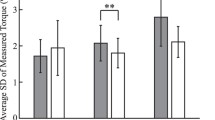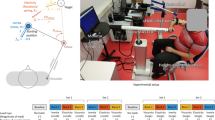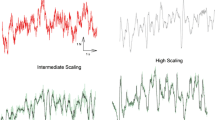Summary
The preceding study of this series (Hening, Favilla and Ghez 1988) examined the time course of the processes by which human subjects use information from a target to set the amplitude of an impulse of isometric elbow force. In that study, subjects were provided with separate cues to time response initiation and to inform them of the required amplitude of the response. When the time between target presentation and response initiation was too brief for them to incorporate information from the target, subjects produced default responses whose amplitudes reflected their prior experience. At longer latencies, subjects specified response amplitude with a gradual time course, starting earlier and ending later than an average reaction time. The present study now examines how two distinct response features, amplitude and direction, are specified following presentation of a target. We sought to answer three main questions. What are the features of responses that are produced before target information is available? Are direction and amplitude specified serially or in parallel? Does the specification of one response feature interfere with the specification of the other? Six normal subjects were studied. They were trained to initiate impulses of isometric elbow force in synchrony with the last of a predictable series of regular tones. The amplitudes and directions were to match those of visual targets requiring flexions or extensions with one of three amplitudes. The targets were presented at random times (0–400 ms) before the last tone. Target directions and amplitudes were either predictable (simple condition) or unpredictable (choice condition). In the simple condition, response amplitudes and directions were independent of the interval between target presentation and response onset (S-R interval). In the choice condition, both amplitude and direction varied with the S-R interval. At short S-R intervals (< 100 ms), the direction of the subjects' responses was not related to that of the target. The amplitudes of the responses were near the centers of the two target ranges. With increasing S-R intervals, the proportion of correct direction responses gradually increased. Over the same range of S-R intervals, the amplitudes of both right and wrong direction responses to the different targets separated and converged on their respective target amplitudes. Specification of both direction and amplitude was complete at S-R intervals greater than 300 ms. The time course of amplitude specification in this bidirectional paradigm was prolonged over that in a paradigm where response direction was predictable. As in our previous reports, subjects varied response amplitude by adjusting the time derivatives of force rather than force rise time. Response trajectories were similar for flexor, extensor, right and wrong direction responses. We conclude first, that the amplitudes of impulsive responses to unpredictable targets are specified from an initial default value even when both amplitude and direction are unpredictable; second, the amplitude and direction of such response are specified gradually by separate processing channels operating in parallel; third, the processing of the two response features is not, however, fully independent. It is suggested that the two processes share a common neural resource.
Similar content being viewed by others
References
Alexander GE, DeLong MR, Strick PL (1986) Parallel organization of functionally segregated circuits linking basal ganglia and cortex. Ann Rev Neurosci 9: 357–381
Becker W, Jurgens R (1979) An analysis of the saccadic system by means of double step stimuli. Vision Res 19: 967–983
Bonnet M, Requin J, Stelmach GE (1982) Specification of direction and extent in motor programming. Bull Psychonom Sci 19: 31–34
Chambers JM, Cleveland WS, Kleiner B, Tukey PA (1983) Graphical methods for data analysis. Duxbury Press, Boston
Cleveland WS (1979) Robust locally weighted regression and smoothing scatterplots. J Am Stat Assoc 74: 829–836
Donders FC (1869) On the speed of mental processes. Translated and reprinted in Acta Psychol 30: 412–431
Duncan J (1980) The demonstration of capacity limitation. Cogn Psychol 12: 75–96
Favilla M, Hening W, Ghez C (1985) Human tracking performance: parallel specification of amplitude and direction. Neuroscience Abstr 11: 72
Favilla M, Hening W, Ghez C (1987) Independent specification of response features in a reaction time paradigm. Neuroscience Abstr 13: 13
Favilla M, Hening W, Gordon J, Ghez C (1986) Preparatory set: independent specification of direction and size in the preparation of responses to a range of targets. Neuroscience Abstr 12: 972
Geldard FA, Sherrick CE (1986) Space, time, and touch. Sci Am 256: 90–95
Ghez C, Gordon J (1987) Trajectory control in targeted force impulses. I. Roles of opposing muscles. Exp Brain Res 67: 225–240
Ghez C, Hening W, Favilla M (1989) Initiation and specification of response features: parallel interacting channels. In: Jeannerod M (ed) Attention and performance, XIII. Ehrlbaum, Hillside New Jersey (in press)
Goodman D, Kelso JAS (1980) Are movements prepared in parts? Not under compatible (naturalized) conditions. J Exp Psychol (Gen) 109: 475–495
Gordon J, Ghez C (1987a) Trajectory control in targeted force impulses. II. Pulse height control. Exp Brain Res 67: 241–252
Gordon J, Ghez C (1987b) Trajectory control in targeted force impulses. III. Compensatory adjustments for initial errors. Exp Brain Res 67: 253–269
Gordon J, Bermejo R, Ghez C (1988) Updating of isometric force trajectories: corrections for unexpected changes in target amplitude. Neuroscience Abstr 14: 467
Gottsdanker R, Shragg GP (1985) Verification of Donders' subtraction method. J Exp Psychol (Hum Percept Perform) 11: 765–776
He P, Kowler E (1987) Motor preparation as a determinant of the accuracy of short-latency saccades. Invest Ophthalmol Visual Sci [Suppl] 28: 332 (ARVO abstract)
Hening W, Favilla M, Ghez C (1988) Trajectory control in targeted force impulses. V. Gradual specification of response amplitude. Exp Brain Res 71: 116–128
Hening W, Vicario D, Ghez C (1988) Trajectory control in targeted force impulses. IV. Influences of choice, prior experience and urgency. Exp Brain Res 71: 103–115
Hubel DS, Livingstone MS (1987) Segregration of form, color, and stereopsis in primate area 18. J Neurosci 7: 3378–3415
Kalaska JF, Caminiti R, Georgopoulos AP (1983) Cortical mechanisms related to the direction of two-dimensional arm movements: relations in parietal area 5 and comparison with motor cortex. Exp Brain Res 51: 247–260
Kalaska JF, Hyde ML (1985) Area 4 and area 5: differences between the load direction-dependent discharge variability of cells during active postural fixation. Exp Brain Res 59: 197–202
Keele SW, Posner MI (1968) Processing of visual feedback in rapid movements. J Exp Psychol 77: 155–158
Kowler E, Martins AJ, Pavel M (1984) The effect of expectation on slow oculomotor control-IV. Anticipatory smooth eye movements depend on prior target motions. Vision Res 24: 197–210
Kowler E, Steinman RM (1979a) The effect of expectation on slow oculomotor control. I. Periodic target steps. Vision Res 19: 619–632
Kowler E, Steinman RM (1979b) The effect of expectation on slow oculomotor control. II. Single target displacements. Vision Res 19: 633–646
Kowler E, Steinman RM (1981) The effect of expectation on slow oculomotor control. III. Guessing unpredictable target displacements. Vision Res 21: 191–203
Livingstone MS, Hubel DH (1987a) Connections between layer 4B of area 17 and thick cytochrome oxidase stripes of area 18 in the squirrel monkey. J Neurosci 7: 3371–3377
Livingstone MS, Hubel DH (1987b) Psychophysical evidence for separate channels for the perception of form, color, movement, and depth. J Neurosci 7: 3416–3468
Megaw ED (1972) Direction and extent uncertainty in step-input tracking. J Motor Behav 3: 171–186
Miller J (1982) Discrete versus continuous stage models of human information processing: in search of partial output. J Exp Psychol (Hum Percept Perform) 8: 273–296
Ottes FP, Van Gisbergen AM, Eggermont JJ (1984) Metrics of saccade responses to visual double stimuli: two different modes. Vision Res 24: 1169–1179
Ottes FP, Van Gisbergen AM, Eggermont JJ (1985) Latency dependence of colour-based target vs nontarget discrimination by the saccadic system. Vision Res 25: 849–862
Pachella RG (1974) The interpretation of reaction time in information processing research. In: Kantowitz B (ed) Human information processing. Erlbaum, Hillside, New Jersey, pp 41–82
Poulton EC (1981) Human manual control. In: Brooks VB (ed) Handbook of physiology, Sect 1. The nervous system, Vol 2. Motor control. American Physiological Society, Bethesda, pp 1337–1389
Rosenbaum DA (1980) Human movement initiation: specification of arm, direction, and extent. J Exp Psychol (General) 109: 444–474
Schouten JF, Bekker JAM (1967) Reaction time and accuracy. Acta Psychol 27: 143–153
Sperling G, Dosher BA (1986) Strategy and optimization in human information processing. In: Boff K, Kaufman L, Thomas J (eds) Handbook of perception and performance, Vol I. Wiley, New York
Stelmach GE, Goggin NL, Garcia-Colera A (1987) Movement specification time with age. Exp Aging Res 13: 39–46
van Asten WNJC, Gielen CCAM, Winkel MEM (1988) The effect of isoluminant and isochromatic stimuli on latency and amplitude of saccades. Vision Res 28: 827–840
van Sonderen JF, Denier van der Gon JJ, Gielen CCAM (1988) Conditions determining early modification of motor programmes in response to changes in target location. Exp Brain Res 71: 320–328
Welford AT (1980) Reaction times. Academic Press, New York
Zelasnik HN (1981) The effects of force and direction uncertainty on choice reaction time in an isometric force production task. J Motor Behav 13: 18–32
Author information
Authors and Affiliations
Rights and permissions
About this article
Cite this article
Favilla, M., Hening, W. & Ghez, C. Trajectory control in targeted force impulses. Exp Brain Res 75, 280–294 (1989). https://doi.org/10.1007/BF00247934
Received:
Accepted:
Issue Date:
DOI: https://doi.org/10.1007/BF00247934




